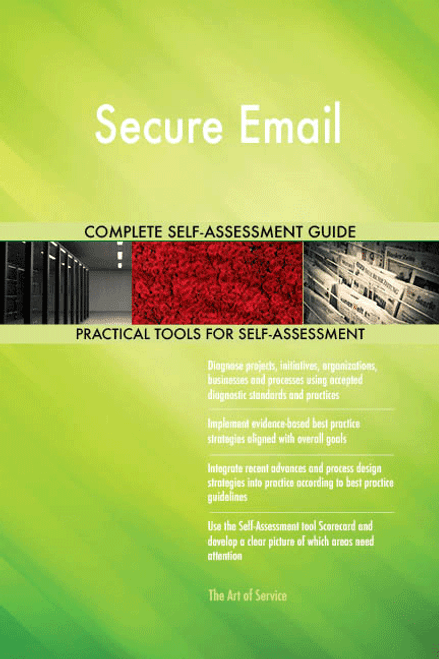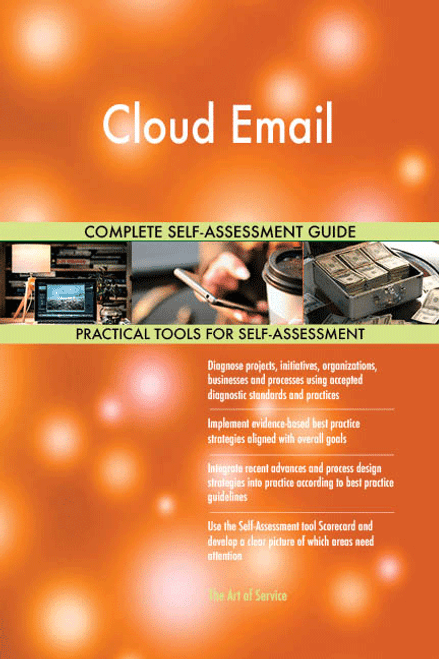Be accountable for installing, upgrading, maintaining and monitoring of corporate Data Loss Prevention (DLP) solutions, Email Security solution, secure messaging solution, multi factor authentication solution and other Information security related systems.
More Uses of the Email Security Toolkit:
- Manage Load Balancers, anti spam and Email Security solutions, and other related appliances and systems.
- Secure that your corporation complies; Continuous Monitoring, tuning, hardening and improvement of the existing Email Security Policies.
- Provide leadership and expertise to further develop Email Security Policies.
- Perform Email Security Administration.
- Configure and maintain Email Security settings.
- Be accountable for maintaining Firewalls, virtual private networks, web protocols, and Email Security.
- Ensure you conduct; and response, Data Loss Prevention (DLP), Web Security gateways and Email Security.
- Determine, develop, plan, test, and implement Email Security requirements for the enterprise.
- Manage local Firewalls, anti spam and Email Security solutions, and other related appliances and/or systems that require updates or management.
- Provide end user support around general Email Security.
- Standardize: detection Security Engineering, Email Security.
- Be accountable for generating and maintaining the virtual private network, Firewalls, web protocols and Email Security decorum.
- Manage Email Security and filtering for clients.
- Supervise: industry standard backup systems, virtual server management systems, network concepts, programming, and hardware, Patch Management, Email Security/filtering, proxy, and Web Security/filtering.
- Lead: Cybersecurity systems as endpoint and Email Security.
Save time, empower your teams and effectively upgrade your processes with access to this practical Email Security Toolkit and guide. Address common challenges with best-practice templates, step-by-step Work Plans and maturity diagnostics for any Email Security related project.
Download the Toolkit and in Three Steps you will be guided from idea to implementation results.
The Toolkit contains the following practical and powerful enablers with new and updated Email Security specific requirements:
STEP 1: Get your bearings
Start with...
- The latest quick edition of the Email Security Self Assessment book in PDF containing 49 requirements to perform a quickscan, get an overview and share with stakeholders.
Organized in a Data Driven improvement cycle RDMAICS (Recognize, Define, Measure, Analyze, Improve, Control and Sustain), check the…
- Example pre-filled Self-Assessment Excel Dashboard to get familiar with results generation
Then find your goals...
STEP 2: Set concrete goals, tasks, dates and numbers you can track
Featuring 999 new and updated case-based questions, organized into seven core areas of Process Design, this Self-Assessment will help you identify areas in which Email Security improvements can be made.
Examples; 10 of the 999 standard requirements:
- How will you insure seamless interoperability of Email Security moving forward?
- Are actual costs in line with budgeted costs?
- Have design-to-cost goals been established?
- How do you Reduce Costs?
- How do you cross-sell and up-sell your Email Security success?
- What are the concrete Email Security results?
- How difficult is it to qualify what Email Security ROI is?
- How will Email Security decisions be made and monitored?
- What controls do you have in place to protect data?
- What is out of scope?
Complete the self assessment, on your own or with a team in a workshop setting. Use the workbook together with the self assessment requirements spreadsheet:
- The workbook is the latest in-depth complete edition of the Email Security book in PDF containing 994 requirements, which criteria correspond to the criteria in...
Your Email Security self-assessment dashboard which gives you your dynamically prioritized projects-ready tool and shows your organization exactly what to do next:
- The Self-Assessment Excel Dashboard; with the Email Security Self-Assessment and Scorecard you will develop a clear picture of which Email Security areas need attention, which requirements you should focus on and who will be responsible for them:
- Shows your organization instant insight in areas for improvement: Auto generates reports, radar chart for maturity assessment, insights per process and participant and bespoke, ready to use, RACI Matrix
- Gives you a professional Dashboard to guide and perform a thorough Email Security Self-Assessment
- Is secure: Ensures offline Data Protection of your Self-Assessment results
- Dynamically prioritized projects-ready RACI Matrix shows your organization exactly what to do next:
STEP 3: Implement, Track, follow up and revise strategy
The outcomes of STEP 2, the self assessment, are the inputs for STEP 3; Start and manage Email Security projects with the 62 implementation resources:
- 62 step-by-step Email Security Project Management Form Templates covering over 1500 Email Security project requirements and success criteria:
Examples; 10 of the check box criteria:
- Cost Management Plan: Eac -estimate at completion, what is the total job expected to cost?
- Activity Cost Estimates: In which phase of the Acquisition Process cycle does source qualifications reside?
- Project Scope Statement: Will all Email Security project issues be unconditionally tracked through the Issue Resolution process?
- Closing Process Group: Did the Email Security project team have enough people to execute the Email Security project plan?
- Source Selection Criteria: What are the guidelines regarding award without considerations?
- Scope Management Plan: Are Corrective Actions taken when actual results are substantially different from detailed Email Security project plan (variances)?
- Initiating Process Group: During which stage of Risk planning are risks prioritized based on probability and impact?
- Cost Management Plan: Is your organization certified as a supplier, wholesaler, regular dealer, or manufacturer of corresponding products/supplies?
- Procurement Audit: Was a formal review of tenders received undertaken?
- Activity Cost Estimates: What procedures are put in place regarding bidding and cost comparisons, if any?
Step-by-step and complete Email Security Project Management Forms and Templates including check box criteria and templates.
1.0 Initiating Process Group:
- 1.1 Email Security project Charter
- 1.2 Stakeholder Register
- 1.3 Stakeholder Analysis Matrix
2.0 Planning Process Group:
- 2.1 Email Security Project Management Plan
- 2.2 Scope Management Plan
- 2.3 Requirements Management Plan
- 2.4 Requirements Documentation
- 2.5 Requirements Traceability Matrix
- 2.6 Email Security project Scope Statement
- 2.7 Assumption and Constraint Log
- 2.8 Work Breakdown Structure
- 2.9 WBS Dictionary
- 2.10 Schedule Management Plan
- 2.11 Activity List
- 2.12 Activity Attributes
- 2.13 Milestone List
- 2.14 Network Diagram
- 2.15 Activity Resource Requirements
- 2.16 Resource Breakdown Structure
- 2.17 Activity Duration Estimates
- 2.18 Duration Estimating Worksheet
- 2.19 Email Security project Schedule
- 2.20 Cost Management Plan
- 2.21 Activity Cost Estimates
- 2.22 Cost Estimating Worksheet
- 2.23 Cost Baseline
- 2.24 Quality Management Plan
- 2.25 Quality Metrics
- 2.26 Process Improvement Plan
- 2.27 Responsibility Assignment Matrix
- 2.28 Roles and Responsibilities
- 2.29 Human Resource Management Plan
- 2.30 Communications Management Plan
- 2.31 Risk Management Plan
- 2.32 Risk Register
- 2.33 Probability and Impact Assessment
- 2.34 Probability and Impact Matrix
- 2.35 Risk Data Sheet
- 2.36 Procurement Management Plan
- 2.37 Source Selection Criteria
- 2.38 Stakeholder Management Plan
- 2.39 Change Management Plan
3.0 Executing Process Group:
- 3.1 Team Member Status Report
- 3.2 Change Request
- 3.3 Change Log
- 3.4 Decision Log
- 3.5 Quality Audit
- 3.6 Team Directory
- 3.7 Team Operating Agreement
- 3.8 Team Performance Assessment
- 3.9 Team Member Performance Assessment
- 3.10 Issue Log
4.0 Monitoring and Controlling Process Group:
- 4.1 Email Security project Performance Report
- 4.2 Variance Analysis
- 4.3 Earned Value Status
- 4.4 Risk Audit
- 4.5 Contractor Status Report
- 4.6 Formal Acceptance
5.0 Closing Process Group:
- 5.1 Procurement Audit
- 5.2 Contract Close-Out
- 5.3 Email Security project or Phase Close-Out
- 5.4 Lessons Learned
Results
With this Three Step process you will have all the tools you need for any Email Security project with this in-depth Email Security Toolkit.
In using the Toolkit you will be better able to:
- Diagnose Email Security projects, initiatives, organizations, businesses and processes using accepted diagnostic standards and practices
- Implement evidence-based best practice strategies aligned with overall goals
- Integrate recent advances in Email Security and put Process Design strategies into practice according to best practice guidelines
Defining, designing, creating, and implementing a process to solve a business challenge or meet a business objective is the most valuable role; In EVERY company, organization and department.
Unless you are talking a one-time, single-use project within a business, there should be a process. Whether that process is managed and implemented by humans, AI, or a combination of the two, it needs to be designed by someone with a complex enough perspective to ask the right questions. Someone capable of asking the right questions and step back and say, 'What are we really trying to accomplish here? And is there a different way to look at it?'
This Toolkit empowers people to do just that - whether their title is entrepreneur, manager, consultant, (Vice-)President, CxO etc... - they are the people who rule the future. They are the person who asks the right questions to make Email Security investments work better.
This Email Security All-Inclusive Toolkit enables You to be that person.
Includes lifetime updates
Every self assessment comes with Lifetime Updates and Lifetime Free Updated Books. Lifetime Updates is an industry-first feature which allows you to receive verified self assessment updates, ensuring you always have the most accurate information at your fingertips.








